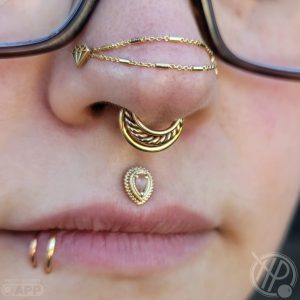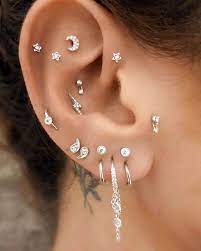
 Body piercing, which is a form of body modification, is the practice of puncturing or cutting a part of the human body, creating an opening in which jewelry may be worn, or where an implant could be inserted.
Body piercing, which is a form of body modification, is the practice of puncturing or cutting a part of the human body, creating an opening in which jewelry may be worn, or where an implant could be inserted.
The word piercing can refers to the act or practice of body piercing, or to an opening in the body created by this act.
It also, by metonymy, refer to by the decorative jewelry used.
Piercing implants alter body and/or skin profile and appearance.
It has been practiced in various forms since ancient times throughout the world.
Ear piercing, nose piercing, lip and tongue piercings, genital piercing, navel piercing have been particularly widespread and documented in historical records.
Reasons for piercing: religious or spiritual reasons, self-expression, for aesthetic value, for sexual pleasure, to conform to their culture or to rebel against it, and to express individuality.
Some sexual abuse survivors choose body piercing as a means of reclaiming body parts from memories of abuse.
Piercing can also be chosen for simple aesthetic value: to highlight particular areas of the body.
The display or placement of piercings have been restricted by schools, employers and religious groups.
There are individuals with hundreds and even thousands of permanent and temporary piercings.
Body piercing is an invasive procedure with some risks, including allergic reaction, infection, excessive scarring and unanticipated physical injuries.
The healing time required for a body piercing varies: as little as a month for some genital piercings to as much as two full years for the navel.
Some piercings may lead to rejection.
A 2005 survey of 10,503 people in England over the age of 16 found that approximately 10% had body piercings in sites other than the earlobe, with a heavy representation of women aged 16–24.
Individuals with piercings are likely to be involved in other forms of countercultural expression as well.
Some pierce themselves , permanently or temporarily, to enhance sexual pleasure, as genital and nipple piercings may increase sexual satisfaction.
Public piercings serve as a mechanism of both accelerated camaraderie and political communication.
Some countries impose parental permission for minors to receive body piercings, and some prohibit piercing private areas of minors, including genitals and nipples, on penalty of fine and imprisonment for the piercer.
Many states in the U.S. also require parental consent to piercing minors, with some also requiring the physical presence of the parents during the act.
The state of Idaho has imposed a minimum age for body piercing at 14.
Body piercing jewellery should be hypoallergenic.
Stainless steel, niobium, titanium, platinum and palladium are commonly used metals, with titanium the least likely to cause allergic reaction.
Initial piercings should not be done with gold of any grade.
Gold is mixed with other metals, and sterling silver is not a good alternative in a piercing, as it may cause allergies in initial piercings and will tarnish in piercings of any age.
Additional risk for allergic reaction may arise from studs or clasps of jewellery is made from a different metal than the primary piece.
Body piercing jewellery is measured by thickness and diameter/length, and most countries use millimeters.
Permanent body piercings are performed by creating an opening in the body using a sharp object, and can either be done by puncturing an opening using a needle or scalpel or by removing tissue, either with a dermal punch or through scalpelling.
The standard method in the United States involves making an opening using a beveled-tip hollow medical needle, available in different lengths, gauges and even shapes.
The needle used is typically the same gauge as the jewellery to be worn, with higher gauges indicating thinner needles.
The needle is inserted into the body part being pierced, and the initial jewellery to be worn in the piercing is pushed through the opening.
A dermal punch is used to remove a circular area of tissue, into which jewellery is placed, and is used for larger cartilage piercings.
The vast majority of women in the west have their ears pierced with a piercing gun.
Forceps, or clamps, may be used to hold and stabilize the tissue to be pierced.
Needle receiving tubes, like forceps, are used to support the tissue at the piercing site and are common in septum and some cartilage piercings.
Anaesthesia may be topical or injected, but piercers and other non-medical personnel are not legally permitted to administer anaesthetics in the United States.
Autoclaves are standard equipment in professional piercing studios, helping to prevent infection.
Body piercing is an invasive procedure with risks.
In a survey of 10,503 persons over the age of 16 in England, complications were reported in 31% of piercings, with professional help being necessary in 15.2% and 0.9% had complications serious enough to require hospitalization.
Risks include:
Allergic reaction to the metal in the piercing jewellery, particularly nickel.
Allergic reactions can be minimized by using high quality jewellery from titanium or niobium or similar inert metals.
Metal piercing jewellery increases the risk of developing a metal.
Infection, bacterial or viral, particularly from Staphylococcus aureus, group A streptococcus and Pseudomonas spp.
Ten to thirty percent of piercings result in local benign bacterial infection.
People that are at greatest risk have congenital heart disease, who have a much higher chance of developing life-threatening infective endocarditis, hemophiliacs and diabetics, as well as those taking corticosteroids.
Viral infections may include hepatitis B, hepatitis C and, potentially, HIV.
An infection due to piercing of the tongue can be fatal, but is rare.
There is a Higher prevalence of colonization of Candida albicans in young individuals with tongue piercing, in comparison to non-tongue-pierced matched individuals.
Excess scar tissue, including hypertrophic scar and keloid formation may occur with piercings.
Piercings can be removed, but may leave a hole, mark or scar.
Physical trauma to the piercing site may cause tearing, friction or bumping, which may cause edema and delay healing.
Recession of gum tissue affects 19% to 68% of individuals with lip and/or intra-oral piercings.
The alveolar tooth-bearing bone may be involved, jeopardizing the stability and durability of the teeth in place and requiring a periodontal regeneration surgery.
Dental fracture and wear affects 14% to 41% of subjects with lip and/or intra-oral ornaments.
Piercing healing process has three stages:
The inflammatory phase
Proliferative phase producing cells and protein to heal the puncture.
A maturation or remodeling phase, as the cells lining the piercing strengthen and stabilize, contracting and forming a tunnel of scar, lasting weeks, months, or longer than a year to complete.
Following piercing a white or slightly yellow discharge is noticeable due to the sebaceous glands producing an oily substance meant to protect and moisturize the wound.
Minimal signs of inflammation or infection are expected after piercing and only within the initial phase.
Healing time from piercing varies widely according to the placement of the piercing.
Genital piercings can be among the quicker to heal.
Navel piercings can be the slowest to heal, due to clothing friction, with a range of six months to two full years.
